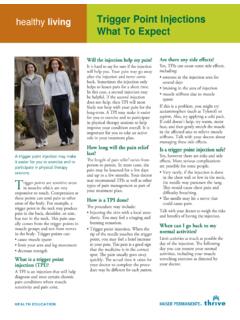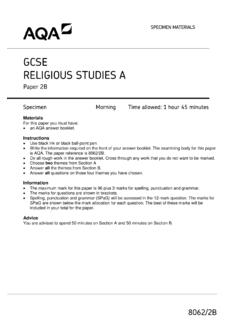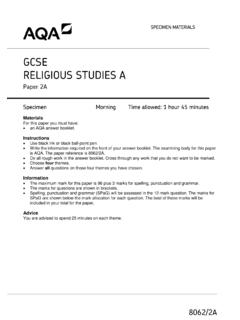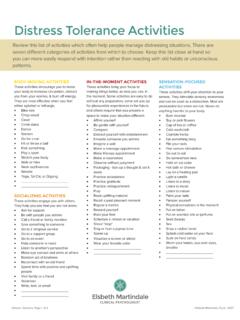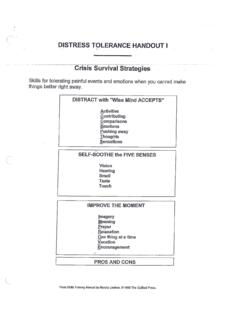Transcription of Distress Tolerance Handouts - Kaiser Permanente
1 Distress Tolerance Handouts DI STRESS Tolerance HANDOUT 1 Goals of Distress Tolerance SURVIVE CRISIS SITUATIONS Without Making Them Worse ACCEPT REALITY Replace Suffering and Being Stuck with Ordinary Pain and the Possibility of Moving Forward BECOME FREE Of Having to Satisfy the Demands of Your Own Desires, Urges, and In tense Emotions OTHER: From DBT Skills Training Handouts and Worksheets, Second Edition, by Marsha M. Linehan. Copyright 2015 by Marsha M. Linehan. Permis-sion to photocopy this handout is granted to purchasers of DBT Skills Training Handouts and Worksheets, Second Edition, and DBT Skills Training M anual, Se c ond Ed ition, for personal use and use with individual clients only. (See page ii of this packet for details.) DI STRESS Tolerance HANDOUT 3 When to Use Crisis Survival Skills YOU ARE IN A CRISIS when the situation is: Highly stressful.
2 Short-term (that is, it won t last a long time)..now Creates intense pressure to resolve the crisis USE CRISIS SURVIVAL SKILLS when: 1. You have intense pain that cannot be helped quickly. 2. You want to act on your emotions, but it will only make things worse. 3. Emotion mind threatens to overwhelm you, and you need to stay skillful. 4. You are overwhelmed, yet demands must be met. 5. Arousal is extreme, but problems can t be solved immediately. DON T USE CRISIS SURVIVAL SKILLS for: Everyday problems. Solving all your life problems. Making your life worth living. From DBT Skills Training Handouts and Worksheets, Second Edition, by Marsha M. Linehan. Copyright 2015 by Marsha M. Linehan. Permis-sion to photocopy this handout is granted to purchasers of DBT Skills Training Handouts and Worksheets, Second Edition, and DBT Skills Training M anual, Se c ond Ed ition, for personal use and use with individual clients only. (See page ii of this packet for details.) ; pp.
3 372 373DI STRESS Tolerance HANDOUT 4 ( Distress Tolerance Worksheets 2, 2a) STOP Skill Stop Do not just react. Stop! Freeze! Do not move a muscle! Your emotions may try to make you act without thinking. Stay in control! Take a step back Take a step back from the situation. Take a break. Let go. Take a deep breath. Do not let your feelings make you act impulsively. Observe Notice what is going on inside and outside you. What is the situation? What are your thoughts and feelings? What are others saying or doing? Proceed mindfully Act with awareness. In deciding what to do, consider your thoughts and feelings, the situation, and other people s thoughts and feelings. Think about your goals. Ask Wise Mind: Which actions will make it better or worse? Note. Adapted from an unpublished worksheet by Francheska Perepletchikova and Seth Axelrod, with their permission. From DBT Skills Training Handouts and Worksheets, Second Edition, by Marsha M. Linehan. Copyright 2015 by Marsha M. Linehan.
4 Permis-sion to photocopy this handout is granted to purchasers of DBT Skills Training Handouts and Worksheets, Second Edition, and DBT Skills Training M anual, Se c ond Ed ition, for personal use and use with individual clients only. (See page ii of this packet for details.) PROS CONS Pros of acting on impulsive urges, Cons of acting on impulsive urges, giving in, giving up, or avoiding what giving in, giving up, or avoiding what needs to be done. needs to be done. Acting on crisis urges Pros of resisting impulsive urges, Cons of resisting impulsive urges, doing what needs to be done, and doing what needs to be done, and not giving up. not giving up.
5 Resisting crisis urges DI STRESS Tolerance HANDOUT 5 ( Distress Tolerance Worksheets 3, 3a573 47. 3p; p) Pros and Cons Use pros and cons any time you have to decide between two courses of action. An urge is a crisis when it is very strong and when acting on the urge will make things worse in the long term. Make a list of the pros and cons of acting on your crisis urges. These might be to engage in dangerous, addictive, or harmful behaviors, or they might be to give in, give up, or avoid doing what is necessary to build a life you want to live. Make another list of the pros and cons of resisting crisis urges that is, tolerating the Distress and not giving in to the urges.
6 Use the grid below to evaluate both sets of pros and cons (this type of grid is also used in Distress Tolerance Worksheet 3). Or you can use the type of grid seen in Distress Tolerance Worksheet 3a and in the pros-and-cons worksheets for other modules. Before an overwhelming crisis urge hits: Write out your pros and cons; carry them with you. Rehearse your pros and cons over and over. When an overwhelming crisis urge hits: Review your pros and cons. Get out your list and read it over again. Imagine the positive consequences of resisting the urge. Think of the negative consequences of giving in to crisis behaviors. Remember past consequences when you have acted on crisis urges. From DBT Skills Training Handouts and Worksheets, Second Edition, by Marsha M. Linehan. Copyright 2015 by Marsha M. Linehan. Permis-sion to photocopy this handout is granted to purchasers of DBT Skills Training Handouts and Worksheets, Second Edition, and DBT Skills Training M anual, Se c ond Ed ition, for personal use and use with individual clients only.
7 (See page ii of this packet for details.) ; p. 376DI STRESS Tolerance HANDOUT 6 ( Distress Tolerance Worksheet 4) TIP Skills: Changing Your Body Chemistry To r e duce ex tr em e emotion mind fast. Remember these as TIP skills: T TIP THE TEMPERATURE of your face with COLD WATER* (to calm down fast) Holding your breath, put your face in a bowl of cold water, or hold a cold pack (or zip-lock bag of cold water) on your eyes and cheeks. Hold for 30 seconds. Keep water above 50 F. I INTENSE EXERCISE* (to calm down your body when it is revved up by emotion) Engage in intense exercise, if only for a short while.
8 Expend your body s stored up physical energy by running, walking fast, jumping, playing basketball, lifting weights, etc. P PACED BREATHING (pace your breathing by slowing it down) Breathe deeply into your belly. Slow your pace of inhaling and exhaling way down (on average, five to six breaths per minute). (for example, 5 seconds in and 7 in more slowly than you breathe out Breathe seconds out). PAIRED MUSCLE RELAXATION (to calm down by pairing muscle relaxation with breathing out) so much as notWhile breathing into your belly deeply tense your body muscles ( to cause a cramp). Notice the tension in your body. While breathing out, say the word Relax in your mind. Let go of the tension. Notice the difference in your body. *Caution: Very cold water decreases your heart rate rapidly. Intense exercise will increase heart rate. Consult your health care provider before using these skills if you have a heart or medical condition, a lowered base heart rate due to medications, take a beta-blocker, are allergic to cold, or have an eating disorder.
9 From DBT Skills Training Handouts and Worksheets, Second Edition, by Marsha M. Linehan. Copyright 2015 by Marsha M. Linehan. Permis-sion to photocopy this handout is granted to purchasers of DBT Skills Training Handouts and Worksheets, Second Edition, and DBT Skills Training M anual, Se c ond Ed ition, for personal use and use with individual clients only. (See page ii of this packet for details.) DI STRESS Tolerance HANDOUT 6A ( Distress Tolerance Worksheet 467. 3; p) Using Cold Water, Step by Step COLD WATER CAN WORK WONDERS* When you put your full face into cold water .. or you put a zip-lock bag with cold water on your eyes and upper cheeks, and hold your breath, it tells your brain you are diving underwater.
10 This causes the dive response to occur. (It may take 15 30 seconds to start.) Your heart slows down, blood flow to nonessential organs is reduced, and blood flow is redirected to the brain and heart. This response can actually help regulate your emotions. This will be useful as a Distress Tolerance strategy when you are having a very strong, distressing emotion, or when you are having very strong urges to engage in dangerous behaviors. (This strategy works best when you are sitting quietly activity and distraction may make it less effective.) TRY IT OUT! *Caution: Very cold water decreases your heart rate. If you have any heart or medical condition, have a lowered base heart rate due to medica-tions, or are on a beta-blocker, consult your health care provider before using these skills. Avoid ice water if you are allergic to the cold. From DBT Skills Training Handouts and Worksheets, Second Edition, by Marsha M. Linehan. Copyright 2015 by Marsha M. Linehan. Permis-sion to photocopy this handout is granted to purchasers of DBT Skills Training Handouts and Worksheets, Second Edition, and DBT Skills Training M anual, Se c ond Ed ition, for personal use and use with individual clients only.







